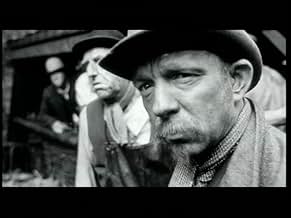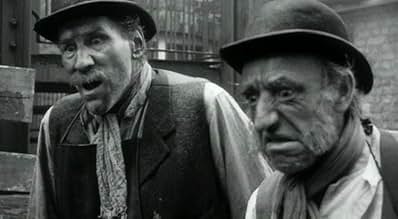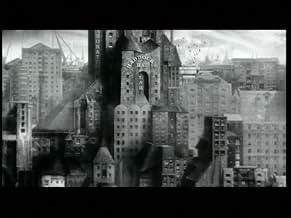Adicionar um enredo no seu idiomaA Dickensian tale of rats, recompense and retribution.A Dickensian tale of rats, recompense and retribution.A Dickensian tale of rats, recompense and retribution.
- Indicado para 1 prêmio BAFTA
- 7 vitórias e 1 indicação no total
Fotos
- Direção
- Roteiristas
- Elenco e equipe completos
- Produção, bilheteria e muito mais no IMDbPro
Enredo
Você sabia?
- ConexõesReferenced in Quarentena (2005)
Avaliação em destaque
One of the surprise Irish films of the last decade, 'Rat', was a surreal concept in a realistic urban setting about a man who one day turns into a rat. Here is an earlier look at rodent life, but one that belongs to a different cinematic tradition. It has many precursors, some literary (Kafka, Dickens, Orwell, Saki etc.), some cinematic (David Lynch (the Gothic recreation of Victorian England in 'The Elephant Man'; the monochrome nightmare of 'Eraserhead'); the short 'Franz Kafka's It's a wonderful life'; Gilliam's 'Brazil'; 'Mousehunt'; the animation of Svankmajer and Starewicz.
The film combines live action, animation and animatronics. Set in an unspecified Victorian locale, it tells the tale of a rat caged in J. Haddock's rodent emporium, where horrific 'scientific' experiments are carried out. When Haddock discovers our hero has mastered the alphabet, he decides to cut off his head to measure his prodigious brain. The rat makes an ingenious escape, but finds the outside world as uncongenial as the laboratory, where a mob nab him and force him into a gruesome rat-fighting contest (having seen 'Amores perros' in the same week, I've had just about enough of this sort of thing). A second escape leads him back to the laboratory, and his doomed rodent comrades. He realises change is not going to come from running away, but by confronting the monster in charge.
This potent short is wonderful for many reasons. Its mastery of the vast mise-en-scene, the creepy laboratory, the teeming streets, the violent pubs, the scientific inventions; its evocative monochrome photography, creating an appropriately Gothic aura; its flitting between genres, tones and styles, from different points of view, all bespeak an exciting new talent. This is one of the great films about the Victorian age, about various kinds of anxieties - the 'progress' of science, where reason and the animal were not so distinct as they might have been; the fear of the mob, and the growing economic and social power of the working class; the joy in new inventions ('Tale' is a dark flipside to the Wallace and Gromit films).
The neat parable-like narrative, has a pleasing Dickensian moral purpose. In an Irish context, the shadow of the Famine over a film set in an era where the Irish were caricatured as beasts to be repressed and exploited, give the film an added resonance, while contemporary issues, such as cloning and animal experiments, are referred to, but with an admirably light touch.
The film combines live action, animation and animatronics. Set in an unspecified Victorian locale, it tells the tale of a rat caged in J. Haddock's rodent emporium, where horrific 'scientific' experiments are carried out. When Haddock discovers our hero has mastered the alphabet, he decides to cut off his head to measure his prodigious brain. The rat makes an ingenious escape, but finds the outside world as uncongenial as the laboratory, where a mob nab him and force him into a gruesome rat-fighting contest (having seen 'Amores perros' in the same week, I've had just about enough of this sort of thing). A second escape leads him back to the laboratory, and his doomed rodent comrades. He realises change is not going to come from running away, but by confronting the monster in charge.
This potent short is wonderful for many reasons. Its mastery of the vast mise-en-scene, the creepy laboratory, the teeming streets, the violent pubs, the scientific inventions; its evocative monochrome photography, creating an appropriately Gothic aura; its flitting between genres, tones and styles, from different points of view, all bespeak an exciting new talent. This is one of the great films about the Victorian age, about various kinds of anxieties - the 'progress' of science, where reason and the animal were not so distinct as they might have been; the fear of the mob, and the growing economic and social power of the working class; the joy in new inventions ('Tale' is a dark flipside to the Wallace and Gromit films).
The neat parable-like narrative, has a pleasing Dickensian moral purpose. In an Irish context, the shadow of the Famine over a film set in an era where the Irish were caricatured as beasts to be repressed and exploited, give the film an added resonance, while contemporary issues, such as cloning and animal experiments, are referred to, but with an admirably light touch.
- the red duchess
- 18 de jul. de 2001
- Link permanente
Principais escolhas
Faça login para avaliar e ver a lista de recomendações personalizadas
Detalhes
- Tempo de duração14 minutos
- Cor
Contribua para esta página
Sugerir uma alteração ou adicionar conteúdo ausente

Principal brecha
By what name was The Tale of the Rat That Wrote (1999) officially released in Canada in English?
Responda










